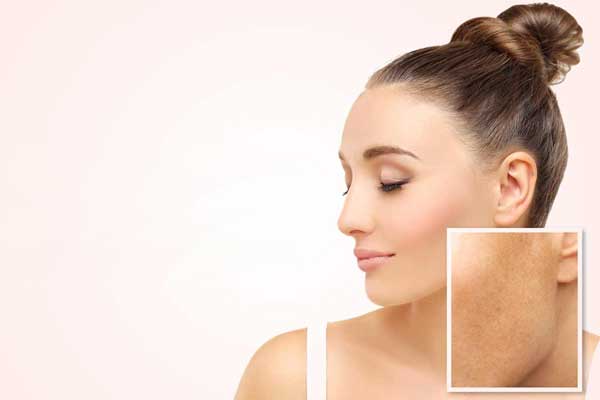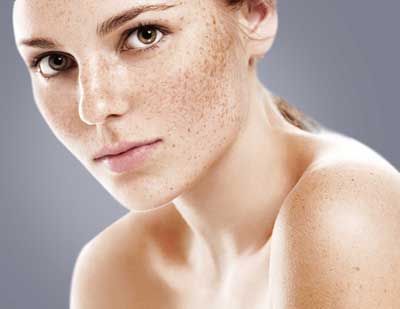 Hyperpigmentation – What are the causes of dark spots and how to reduce them?
Hyperpigmentation – What are the causes of dark spots and how to reduce them?
Uneven skin pigmentation (or hyperpigmentation as it is commonly known) is a common skin problem. Dark spots – known as age spots or sun-induced spots – or dark areas of skin usually appear on the face, hands and other areas of the body that are regularly exposed to the sun. This article summarizes the different types of hyperpigmentation and explains what causes them. Let’s look at how you can help prevent hyperpigmentation from ever appearing, but also at the steps you can take to reduce blemishes or dark spots after they’ve appeared.
What is hyperpigmentation and what are the different types of this problem?
Hyperpigmentation is the term used to describe areas of skin with uneven pigmentation. Hyperpigmentation manifests as dark spots or areas on the skin that give it an uneven appearance. Spots are known as age spots or sun-induced spots, and hyperpigmentation is also at the root of skin problems like melasma or post-inflammatory hyperpigmentation. People with dark skin are usually more affected by hyperpigmentation marks than people with lighter skin tone, because skin pigmentation is stronger in dark skin.
Hyperpigmentation: pigment spots such as age spots Pigment spots such as age spots (which are also known as sun-induced spots) are caused by exposure to the sun. It is for this reason that they appear mainly in areas of the body that are frequently exposed to sunlight, such as the face, neck, décolleté, hands and arms. They tend to be small patches of darker skin. You can find out more about what causes this problem and find out more about how to reduce it in: “What causes age spots and how can I reduce them?
Hyperpigmentation: melasma
Also known as chloasma, melasma is a skin disorder in which large patches of hyperpigmentation develop, particularly on the face. Although it can affect both men and women, melasma is more common in the latter and is thought to be triggered by changes in hormone levels. Melasma occurs in 10-15% of pregnant women and 10-25% of women taking oral contraceptives and is sometimes called the “pregnancy mask”. Hyperpigmentation: Post-inflammatory hyperpigmentation Post-inflammatory hyperpigmentation occurs when healing from a skin injury or trauma results in a flat, discolored area. It is common in acne sufferers and can also be caused by cosmetic procedures such as dermabrasion, laser treatment and chemical peels.
There are other factors that can lead to darkening of certain areas of the skin – such as scarring, birthmarks, solar or actinic keratoses and skin cancers – but these processes or disorders are not considered to be forms of hyperpigmentation. Attention Consult your dermatologist or pharmacist if you are concerned about a dark spot or if it starts to bleed, itch or change size or color.
Causes and Triggering Factors
What are the causes and/or triggers of hyperpigmentation?
Hyperpigmentation is caused by an increase in melanin. Melanin is the pigment that gives color to the skin, hair and eyes. There are some factors that can trigger an increase in melanin production, but the main ones are sun exposure, hormonal influences, age and skin damage or inflammation.
Sun exposure and hyperpigmentation Exposure to the sun is the main cause of hyperpigmentation, because it is sunlight that triggers the production of melanin in the first place. Melanin acts as a natural sunscreen for the skin and protects us from harmful ultraviolet rays, which is why people get tan when exposed to the sun. But excessive exposure to the sun can disrupt this process, leading to hyperpigmentation. Once dark spots have developed, exposure to the sun can also make the problem worse, further darkening age spots (or sun-induced spots), melasma, and post-inflammatory hyperpigmentation spots.

Hyperpigmentation and hormones
Hormonal influences are the main cause of a particular type of hyperpigmentation known as melasma or chloasma. It is particularly common among women and is thought to occur when estrogen and progesterone, the female sex hormones, stimulate excess melanin production if the skin is exposed to the sun. Hyperpigmentation also constitute a side effect of certain hormonal treatments. Hyperpigmentation and age As the skin ages, the number of melanin-producing cells (known as melanocytes) decreases, but the rest increase in size and their skin distribution becomes less uniform. These physiological changes explain the increase in age spots in people over 40 years of age. You can find out more about how your skin ages in the section on skin aging.
Hyperpigmentation, skin lesions and inflammation
As its name suggests, post-inflammatory hyperpigmentation occurs following a skin injury or inflammation, such as: cuts, burns, exposure to chemicals, acne, atopic dermatitis and psoriasis. The skin becomes darker and discolored after the lesion has healed.
Hyperpigmentation, disease and medication
Hyperpigmentation is also a symptom of some disorders, such as some autoimmune diseases and gastrointestinal diseases, metabolic disorders and vitamin deficiencies. It can also be triggered by certain types of medication, such as chemotherapy drugs, antibiotics, antimalarials, and anticonvulsants.
Solutions
How can I prevent hyperpigmentation from forming?
Sun protection is the most important step you can take to help prevent hyperpigmentation from ever forming. It's important to remember that the sun's rays affect the skin even on cloudy days, so you should give your skin the daily protection it needs. In addition to reducing hyperpigmentation, Eucerin Anti-Pigment Day Cream SPF 30 ensures effective protection against UVA and UVB (SPS 30) and prevents the further formation of sun-induced pigmentation spots.
Reducing skin exposure to the sun will also help reduce cases of hyperpigmentation. Try not to be out in the sun during the most intense hours of exposure and wear protective clothing including a hat and sunglasses whenever possible. When the skin is exposed to the sun, regularly apply and
reapply a sunscreen product:
- with an appropriate FPS grade
- that has been specially formulated for your skin type and condition.
You can find out more about the Eucerin line of products with high sun protection here.
Hyperpigmentation removal: dermatological treatments
Dermatological treatments, such as chemical peels and laser therapy, can help reduce hyperpigmentation:
- chemical peels involve applying a chemical solution to the face, neck, and hands to exfoliate the skin (ie, remove dead skin cells), stimulate the growth of new skin cells, and reveal new skin. Find out more about chemical peels in: “What are chemical peels and how do they
work? - laser therapies have a very similar effect, but are generally more accurate because the dermatologist has more control over the intensity of treatment. These therapies involve “discharges” on the affected areas with high energy light. Milder treatments focus only on the skin’s epidermis (the most superficial layer), while more intense treatments can penetrate the deeper layers of the skin.
Dermatologists may also prescribe and/or use hydroquinone, which is still considered to be the most effective topical agent in reducing hyperpigmentation. This agent, however, can only be used for limited periods of time because, like other forms of chemical peeling and laser treatment, it can irritate the skin and actually cause post-inflammatory hyperpigmentation, especially in people with darker skin.
